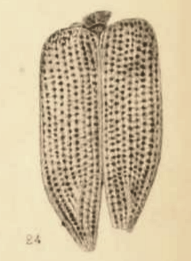|
Angarosphecidae
Angarosphecidae is an extinct family of Mesozoic and early Cenozoic wasps in the superfamily Apoidea. Genera * †'' Angarosphex'' Rasnitsyn 1975 Weald Clay, United Kingdom, Hauterivian/Barremian La Pedrera de Rúbies Formation, Spain, Barremian Crato Formation, Brazil, Aptian Laiyang Formation, Yixian Formation, China, Aptian Gurvan-Eren Formation, Mongolia, Aptian Zaza Formation, Turga Formation, Russia, Aptian Sinuiju Formation, North Korea, Aptian *†'' Baissodes'' Rasnitsyn 1975 Weald Clay, United Kingdom, Hauterivian Yixian Formaiton, China, Aptian Gurvan-Eren Formation, Mongolia, Aptian Zaza Formation, Russia, Aptian * †'' Burmasphex'' Melo and Rosa, 2018, Burmese amber, Myanmar, Cenomanian *†'' Cretobestiola'' Pulawski and Rasnitsyn 2000 La Pedrera de Rúbies Formation, Spain, Barremian Crato Formation, Brazil, Aptian, Dzun-Bain Formation, Mongolia, Aptian Zaza Formation, Argun Formation, Russia, Aptian * †'' Cretosphecium'' Pulawski and Rasnitsyn 2000 Dzun-Bai ... [...More Info...] [...Related Items...] OR: [Wikipedia] [Google] [Baidu] |
Apoidea
The superfamily (zoology), superfamily Apoidea is a major group within the Hymenoptera, which includes two traditionally recognized lineages, the "sphecidae, sphecoid" wasps, and the bees. Molecular phylogeny demonstrates that the bees arose from within the traditional "Crabronidae", so that grouping is paraphyletic, and this has led to a reclassification to produce monophyletic families.Manuela Sann, Oliver Niehuis, Ralph S. Peters, Christoph Mayer, Alexey Kozlov, Lars Podsiadlowski, Sarah Bank, Karen Meusemann, Bernhard Misof, Christoph Bleidorn and Michael Ohl (2018) Phylogenomic analysis of Apoidea sheds new light on the sister group of bees. ''BMC Evolutionary Biology'' 18:71. doi:10.1186/s12862-018-1155-8 Nomenclature Bees appear in recent classifications to be a specialized lineage of "Crabronidae, crabronid" wasps that switched to the use of pollen and nectar as larval food, rather than insect prey; this makes the traditional "Crabronidae" a paraphyletic group. Accordingl ... [...More Info...] [...Related Items...] OR: [Wikipedia] [Google] [Baidu] |
Burmese Amber
Burmese amber, also known as Burmite or Kachin amber, is amber from the Hukawng Valley in northern Myanmar. The amber is dated to around 100 million years ago, during the latest Albian to earliest Cenomanian ages of the mid-Cretaceous period. The amber is of significant palaeontological interest due to the diversity of flora and fauna contained as inclusions, particularly arthropods including insects and arachnids but also birds, lizards, snakes, frogs and fragmentary dinosaur remains. The amber has been known and commercially exploited since the first century AD, and has been known to science since the mid-nineteenth century. Research on the deposit has attracted controversy due to its alleged role in funding internal conflict in Myanmar and hazardous working conditions in the mines where it is collected. Geological context, depositional environment and age The amber is found within the Hukawng Basin, a large Cretaceous-Cenozoic sedimentary basin within northern Myanmar. The s ... [...More Info...] [...Related Items...] OR: [Wikipedia] [Google] [Baidu] |
Mesozoic
The Mesozoic Era ( ), also called the Age of Reptiles, the Age of Conifers, and colloquially as the Age of the Dinosaurs is the second-to-last era of Earth's geological history, lasting from about , comprising the Triassic, Jurassic and Cretaceous Period (geology), Periods. It is characterized by the dominance of archosaurian reptiles, like the dinosaurs; an abundance of conifers and ferns; a hot Greenhouse and icehouse earth, greenhouse climate; and the tectonic break-up of Pangaea. The Mesozoic is the middle of the three eras since Cambrian explosion, complex life evolved: the Paleozoic, the Mesozoic, and the Cenozoic. The era began in the wake of the Permian–Triassic extinction event, the largest well-documented mass extinction in Earth's history, and ended with the Cretaceous–Paleogene extinction event, another mass extinction whose victims included the non-avian dinosaurs, Pterosaur, pterosaurs, Mosasaur, mosasaurs, and Plesiosaur, plesiosaurs. The Mesozoic was a time of ... [...More Info...] [...Related Items...] OR: [Wikipedia] [Google] [Baidu] |
Mesorhopalosoma
''Mesorhopalosoma'' is an extinct genus of wasps in family Rhopalosomatidae Rhopalosomatidae is a family of Hymenoptera containing about 68 extant species in four genera that are found worldwide. Three fossil genera are known. The adults resemble ants and may be confused with them. They are yellowish with red or brown m .... Taxonomy The genus contains the following species: *'' Mesorhopalosoma cearae'' Darling, 1990 References Hymenoptera genera Rhopalosomatidae {{vespoidea-stub Prehistoric insect genera ... [...More Info...] [...Related Items...] OR: [Wikipedia] [Google] [Baidu] |
Ypresian
In the geologic timescale the Ypresian is the oldest age (geology), age or lowest stage (stratigraphy), stratigraphic stage of the Eocene. It spans the time between , is preceded by the Thanetian Age (part of the Paleocene) and is followed by the Eocene Lutetian Age. The Ypresian is consistent with the lower Eocene. Events The Ypresian Age begins during the throes of the Paleocene–Eocene Thermal Maximum (PETM). The Fur Formation in Denmark, the Messel shales in Germany, the Oise amber of France and Cambay amber of India are of this age. The Eocene Okanagan Highlands are an uplands subtropical to temperate series of lakes from the Ypresian. Stratigraphic definition The Ypresian Stage was introduced in scientific literature by Belgium, Belgian geologist André Hubert Dumont in 1850. The Ypresian is named after the Flanders, Flemish city of Ypres in Belgium (spelled ''Ieper'' in Dutch). The definitions of the original stage were totally different from the modern ones. The Ypresi ... [...More Info...] [...Related Items...] OR: [Wikipedia] [Google] [Baidu] |
Coldwater Beds
The Coldwater Beds are a geologic formation of the Okanagan Highlands in British Columbia, Canada. They preserve fossils dating back to the Ypresian stage of the Eocene period, or Wasatchian in the NALMA classification.Coldwater Beds at Fossilworks.org The formation comprises mudstones, shales and s deposited in a |


